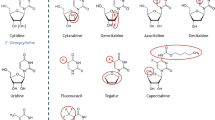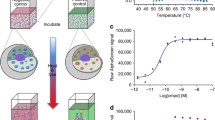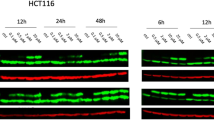Abstract
We have analysed the cellular metabolism of a novel thymidylate synthase (TS) inhibitor, ZD1694, in MOLT-3 and K562 human leukaemia cell lines sensitive to or made resistant to ZD1694 by continuous exposure of the cells to ZD1694 with stepwise escalation of the drug concentration. The initial cellular uptake of [3H]ZD1694 was greater in K562 cells than in MOLT-3 cells and the drug accumulated approximately 3-fold more in the former cells following incubation with 0.1 μM ZD1694 at 37°C for 24 h. TS and dihydrofolate reductase activities were not significantly different between the two cell lines. After a 30-min incubation with the drug at 37°C, 85% of the total drug (2.3pmol/mg protein) in K562 cells was found as tri-to pentaglutamates, whereas MOLT-3 cells accumulated less drug in this time (0.83 pmol/mg protein) and polyglutamates of chain length greater than triglutamate were not found to a significant extent. When the incubation time was extended to 24 h, the polyglutamate profile in K562 cells was progressively shifted towards those of long glutamate chain length and 59% of the total cellular drug (204 pmol/mg protein) was identified as the penta form. In contrast, even distribution between tri-and pentaglutamate was observed in MOLT-3 cells. Total cellular polyglutamates were approximately 3-fold higher in K562 cells than in MOLT-3 cells, and this may explain the 2.5-fold difference in the sensitivity to ZD1694 between the two cell lines. Continuous exposure of MOLT-3 and K562 cells to ZD1694 up to 1 μM or 0.1μM resulted in 1600-and 4200-fold resistant sublines, respectively (MOLT-3/ZD1694·C and K562/ZD1694·C). The resistant MOLT-3 cells showed a markedly lower cellular accumulation and poor retention of [3H]ZD1694 with no significant change of initial drug uptake by 10 min and with a little increase of TS activity. HPLC analysis demonstrated that more than 90% of the3H co-eluted with the monoglutamate (parent drug) in the resistant MOLT-3 cells, indicating extremely diminished polyglutamation in the cells. On the other hand, cellular uptake of [3H]ZD1694 was extensively impaired in K562/ZD1694·C cells and cellular accumulation of the drug was only 2.5% of that in the parent cells following 24 h incubation with the drug. Neither an increase of TS or dihydrofolate reductase activity nor a change in the polyglutamate formation profile was observed in the resistant K562 cells. These results indicate that the cellular ability to produce the polyglutamate metabolites of ZD1694 must influence the sensitivity of the tumour cells to this drug, and development of mechanisms involved in the ZD1694 resistance may relate to the intrinsic biochemical properties of the cells.
Similar content being viewed by others
Abbreviations
- TS :
-
thymidylate synthase
- DHFR :
-
dihydrofolate reductase
- CB3717 :
-
N 10-propargyl-5,8-dideazafolic acid
- HPLC :
-
high-performance liquid
References
Arkin H, Ohnuma T, Kamen BA, Holland JF, Vallabhajosula S (1989) Multidrug resistance in a human leukemic cell line selected for resistance to trimetrexate. Cancer Res 49:6556–6561
Barakat RR, Lovelace CIP, Li WW, Bertino JR (1994) Decreased formation of methotrexate (MTX) polyglutamates in cervical squamous cell carcinoma (SCC) cell lines intrinsically resistant to MTX is associated with decreased expression of folylpoly-glutamyl synthetase (FPGS). Proc Am Assoc Cancer Res 35:305
Bertino JR, Mini E, Sobrero A, Moroson BA, Love T, Jastreboff M, Carmen M, Srimatkandada S, Dube S (1986) Methotrexate resistant cells as targets for selective chemotherapy. Adv Enzyme Regul 24:3–11
Bertino, JR, Li WW, Lin J, Trippett T, Goker E, Schweitzer B, Banerjee D (1992) Enzymes of the thymidylate cycle as targets for chemotherapeutic agents: Mechanisms of resistance. Mt Sinai J Med 59:391–395
Bisset GMF, Pawelczak K, Jackman AL, Calvert AH, Hughes LR (1992) The synthesis and thymidylate synthase inhibitory activity of the poly-γ-glutamyl conjugates of ICI D1694 and other quinazoline antifolates. J Med Chem 35:859–866
Calvert AH, Jones TR, Dady PJ, Grzelakowska-Sztabert B, Paine RM, Taylor GA, Harrap KR (1980) Quinazoline antifolates with dual biochemical loci of action. Biochemical and biological studies directed towards overcoming methotrexate resistance. Eur J Cancer 16:713–722
Gates SB, Schultz RM, Self TD, Grindey GB, Mendelsohn LG (1994) Folylpolyglutamate synthetase activity in normal and neoplastic murine tissues and human tumor xenografts. Proc Am Assoc Cancer Res 35:303
Gibson W, Bisset GMF, Marsham PR, Kelland LR, Judson IR, Jackman AL (1993) The measurement of polyglutamate metabolites of the thymidylate synthase inhibitor, ICI D1694, in mouse and human cultured cells. Biochem Pharmacol 45:863–869
Jackman AL, Alison DL, Calvert AH, Harrap KR (1986) Increased thymidylate synthase in L1210 cells possessing acquired resistance toN 10-propargyl-5,8-dideazafolic acid (CB3717): development, characterization, and cross-resistance studies. Cancer Res 46:2810–2815
Jackman AL, Taylor GA, O'Connor BM, Bishop JA, Moran RG, Calvert AH (1990) Activity of the thymidylate synthase inhibitor 2-desamino-N 10-propargyl-5,8-dideazafolic acid and related compounds in murine (L1210) and human (W1L2) systems in vitro and L1210 in vivo. Cancer Res 50:5212–5218
Jackman AL, Taylor GA, Gibson W, Kimbell R, Brown M, Calvert AH, Judson IR, Hughes LR (1991a) ICI D1694, a quinazoline antifolate thymidylate synthase inhibitor that is a potent inhibitor of L1210 tumor cell growth in vitro and in vivo: a new agent for clinical study. Cancer Res 51:5579–5586
Jackman AL, Marsham PR, Moran RG, Kimbell R, O'Connor BM, Hughes LR, Calvert AH (1991b) Thymidylate synthase inhibitors: the in vitro activity of a series of heterocyclic benzoyl ring modified 2-desamino-2-methyl-N 10-substituted-5,8-dideazafolates. Adv Enzyme Regul 31:13–27
Jackman AL, Kelland LR, Kimbell R, Brown M, Gibson W, Aherne GW, Hardcastle A, Boyle T (1995a) Mechanisms of acquired resistance to the quinazoline thymidylate synthase inhibitor, ICI D1694 (Tomudex) in one mouse and three human cell lines. Br J Cancer 71:914–924
Jackman AL, Farrugia DC, Gibson W, Kimbell R, Harrap KR (1995b) ZD1694 (Tomudex): a new thymidylate synthase inhibitor with activity in colorectal cancer. Eur J Cancer 31A:1277–1282
Jackson RC, Hart LI, Harrap KR (1976) Intrinsic resistance to methotrexate of cultured mammalian cells in relation to the inhibition kinetics of their dihydrofolate reductases. Cancer Res 36:1991–1997
Jansen G, Schornagel JH, Westerhof GR, Rijksen G, Newell DR, Jackman AL (1990) Multiple membrane transport systems for the uptake of folate-based thymidylate synthase inhibitors. Cancer Res 50:7544–7548
Lefebvre SE, Rollins SL, Melera PW (1995) Mutation in a putative reduced folate carrier contributes to methotrexate resistance in the methotrexate resistant cell line DC-3F/A55. Proc Am Assoc Cancer Res 36:376
Li WW, Lin JT, Tong WP, Trippett TM, Brennan MF, Bertino JR (1992a) Mechanisms of natural resistance to antifolates in human soft tissue sarcomas. Cancer Res 52:1434–1438
Li WW, Lin JT, Schweitzer BI, Tong WP, Niedzwiecki D, Bertino JR (1992b) Intrinsic resistance to methotrexate in human soft tissue sarcoma cell lines. Cancer Res 52:3908–3913
Lin JT, Tong WP, Trippett TM, Niedzwiecki D, Tao Y, Tan C, Steinherz P, Schweitzer BI, Bertino JR (1991) Basis for natural resistance to methotrexate in human acute non-lymphocytic leukemia. Leukemia Res 15:1191–1196
Lozzio CB, Lozzio BB (1975) Human chronic myelogenous leukemia cell line with positive Philadelphia chromosome. Blood 45:321–334
Minowada J, Ohnuma T, Moore GE (1972) Rosette-forming human lymphoid cell lines. I. Establishment and evidence for origin of thymus-derived lymphocytes. J Natl Cancer Inst 49:891–895
Moscow JA, He R, Gong M, Sgagias MK, Connolly T, Cowan KH (1995) Isolation and characterization of cDNA and genomic clones encoding a human reduced folate carrier. Proc Am Assoc Cancer Res 36:379
Mosmann T (1983) Rapid colorimetric assay for cellular growth and survival: application to proliferation and cytotoxicity assays. J Immunol Methods 65:55–63
O'Connor BM, Jackman AL, Crossley PH, Freemantle SE, Lunec J, Calvert AH (1992) Human lymphoblastoid cells with acquired resistance toC 2-desamino-C 2-methyl-N 10-propargyl-5,8-dideazafolic acid: a novel folate-based thymidylate synthase inhibitor. Cancer Res 52:1137–1143
Ohnoshi T, Ohnuma T, Takahashi I, Scanlon KJ, Kamen BA, Holland JF (1982) Establishment of methotrexate-resistant human acute lymphoblastic leukemia cells in culture and effects of folate antagonists. Cancer Res 42:1655–1660
Ohnuma T, Lo RJ, Scanlon KJ, Kamen BA, Ohnoshi T, Wolman SR, Holland JF (1985) Evolution of methotrexate resistance of human acute lymphoblastic leukemia cells in vitro. Cancer Res 45:1815–1822
Pizzorno G, Chang YM, McGuire JJ, Bertino JR (1989) Inherent resistance of human squamous carcinoma cell lines to methotrexate as a result of decreased polyglutamylation of this drug. Cancer Res 49:5275–5280
Sikora E, Jackman AL, Newell DR, Calvert AH (1988) Formation and retention and biological activity ofN 10-propargyl-5,8-dideazafolic acid (CB3717) polyglutamates is L1210 cells in vitro. Biochem Pharmacol 37:4047–4054
Takemura Y, Ohnuma T (1992)N 10-Propargyl-5,8-dideazafolic acid (CB3717): inhibitory effects on human leukemia cell lines resistant to methotrexate or trimetrexate. Mt Sinai J Med 59:419–424
Takemura Y, Ohnuma T, Chou TC, Okano T, Holland JF (1985) Biologic and pharmacologic effects of harringtonine on human leukemia-lymphoma cells. Cancer Chemother Pharmacol 14:206–210
Takemura Y, Kobayashi H, Miyachi H, Hayashi K, Sekiguchi S, Ohnuma T (1991a) The influence of tumor cell density on cellular accumulation of doxorubicin or cisplatin in vitro. Cancer Chemother Pharmacol 27:417–422
Takemura Y, Ohnuma T, Miyachi H, Sekiguchi S (1991b) A human leukemia cell line made resistant to two folate analogues, trimetrexate andN 10-propargyl-5,8-dideazafolic acid (CB3717). J Cancer Res Clin Oncol 117:519–525
Ward WHJ, Kimbell R, Jackman AL (1992) Kinetic characteristics of ICI D1694: a quinazoline antifolate which inhibits thymidylate synthase. Biochem Pharmacol 43:2029–2031
Author information
Authors and Affiliations
Rights and permissions
About this article
Cite this article
Takemura, Y., Gibson, W., Kimbell, R. et al. Cellular pharmacokinetics of ZD1694 in cultured human leukaemia cells sensitive, or made resistant, to this drug. J Cancer Res Clin Oncol 122, 109–117 (1996). https://doi.org/10.1007/BF01226268
Received:
Accepted:
Issue Date:
DOI: https://doi.org/10.1007/BF01226268




